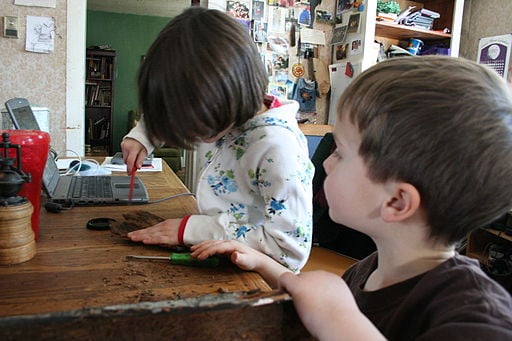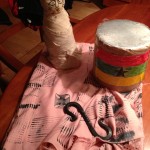Is it possible to cultivate curiosity? You can squelch it, for sure, but can you cultivate it?
As we drove home from my parents house on Monday, Zach announced, “I want to do an experiment tomorrow.”
Taking charge of his own learning is not Zach’s strong suit, so I was delighted by this suggestion. “What kind of experiment do you want to do?”
“I want to make a rubber band ball.”
“Mmmhmm. And what kind of experiment would we do with it?”
“Just make the ball.”
“Well, that sounds like a great project, but an experiment is a way of getting information to answer a question you have. Do you have any questions about rubber band balls that we could try to answer?”
“No. I just want to make the ball.”
Ezra had a question. He wanted to know if a rubber band ball would float? Jeff had a question. He wanted to know if the ball would bounce better or worse, depending on what material you used for the core of the ball. But Zach resisted my attempts to get him to come up with a question. “I just want to make a rubber band ball. That’s all.”
I had a professor who said that a science teacher should never have students do an experiment if he or she already knew what the result would be. “If you know what color the liquid will turn, just tell them.”
Instead, he advocated helping students device experiments to answer their real questions. I loved this approach. And given how few real questions I could answer for my students, it left a wide swath of experiments available to us. What do you do, though, if your student doesn’t have questions?
I couldn’t think of how to help Zach develop a question, so I let him use Jeff’s question, and off we went to buy bags and bags of rubber bands.

Sissy was home from school yesterday and, as it turns out, is somewhat of a rubber band ball expert. She and the boys started four balls, each with a different core: a musket ball, paper, tin foil, and silly putty. They worked on the balls over two days, with me interrupting their efforts at times in order to have them write a lab report in their science journals.
The reports are not what Zach had in mind when he asked to do an experiment, but we need to get in more writing so I forged ahead. I didn’t push them to make their results relate to their research questions, and they didn’t throw anything, or scream, or cry during the writing. (Sadly, that’s my new measure of whether or not the task is hitting the sweet spot of a “just right” challenge – not too easy, not too hard.)
Below is Zach’s report. Read it over and let me know what you think. Is there anything about this project that promotes curiosity? Develops critical thinking? Inspires a love of learning? Or should I have simply let him make a rubber band ball without turning it into something more? I’d love to hear from teachers, students, homeschoolers, and anyone who has ever thought about science education (hint, hint, Catherine Crouch).
_______________________________________________
Rubber Ball Experiment
Questions: 1. Does it bounce? 2 Does it matter what it has inside? (paper, foil, putty, musket)
Prediction: 1. yes, when it has lots of bands. 2. Yes I do (foil) ball will bounce the highest.
Methods: Roll foil in too ball. Roll paper in too ball. Roll putty into ball. put bands on balls. then bounce
The musket kept losing bands. And the putty’s bands kept sinking in.

Results: 1. The tinfoil ball is the second biggest. 2. The putty ball was the easiest to make because bands stuck to it. 3. All the balls have diffrent Colors. 4. The balls bounce higher as they get more bands. 5. The musket ball has the heavyest core. 6. The Musket ball has the lowest bounce.











